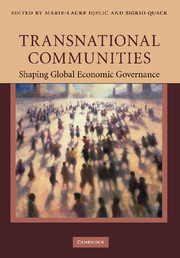Book contents
- Frontmatter
- Contents
- List of figures
- List of tables
- List of appendices
- Contributors
- Preface
- Part I Introduction
- Part II Classical communities with a transnational extension
- Part III Professional communities with a transnational extension
- Part IV Virtual communities
- Part V Transnational interest- or issue-based communities
- 11 The transnational temperance community
- 12 Industrial democracy in the European Community: trade unions as a defensive transnational community, 1968–1988
- 13 The making of a comprehensive transnational discourse community trade unions as a defensive transnational community, 1968–1988
- 14 Global warming, transnational communities, and economic entrepreneurship: the case of carbon capture and storage (CCS)
- 15 Communities of practice as cause and consequence of transnational governance: the evolution of social and environmental certification
- Part VI Conclusion
- Index
- References
14 - Global warming, transnational communities, and economic entrepreneurship: the case of carbon capture and storage (CCS)
Published online by Cambridge University Press: 07 September 2010
- Frontmatter
- Contents
- List of figures
- List of tables
- List of appendices
- Contributors
- Preface
- Part I Introduction
- Part II Classical communities with a transnational extension
- Part III Professional communities with a transnational extension
- Part IV Virtual communities
- Part V Transnational interest- or issue-based communities
- 11 The transnational temperance community
- 12 Industrial democracy in the European Community: trade unions as a defensive transnational community, 1968–1988
- 13 The making of a comprehensive transnational discourse community trade unions as a defensive transnational community, 1968–1988
- 14 Global warming, transnational communities, and economic entrepreneurship: the case of carbon capture and storage (CCS)
- 15 Communities of practice as cause and consequence of transnational governance: the evolution of social and environmental certification
- Part VI Conclusion
- Index
- References
Summary
Introduction
The oil crises in the 1970s made national governments in countries such as the USA, Japan, Germany, Israel, Denmark, Sweden, and many others aware of their oil dependence and the threat to national security it created. At the same time, there was greater public awareness of the environmental problems created by carbon-based energy systems. National policies were put in place to promote new “clean” energy systems, such as solar, wind, wave, and bio-energy.
Policy instruments varied between subsidies – such as “feed-in tariffs” or subsidized prices to owners of wind or solar energy production infrastructure when they sell electricity to the public grid in countries such as Japan or Germany – tax relief (as in the USA), and government funding for R&D investments. During the 1970s and 1980s, these national R&D efforts were supported by NGOs and reinforced by industrial entrepreneurs and suppliers of technology. These national technological systems of innovation developed green technologies and made the new energy systems more efficient and hence more competitive with carbon-based energies (Jakobsson et al. 2002). Such developments were endorsed and encouraged by a number of transnational institutions. In the course of the 1970s, there was a rift between the “green” movement, promoting “clean and green” technology solutions that at the time were inefficient and seemed to be of little economic significance, and “industrial interests,” promoting economic growth while generating pollution. At the time, only a minority saw the possibility of a compromise between these positions.
- Type
- Chapter
- Information
- Transnational CommunitiesShaping Global Economic Governance, pp. 327 - 346Publisher: Cambridge University PressPrint publication year: 2010



